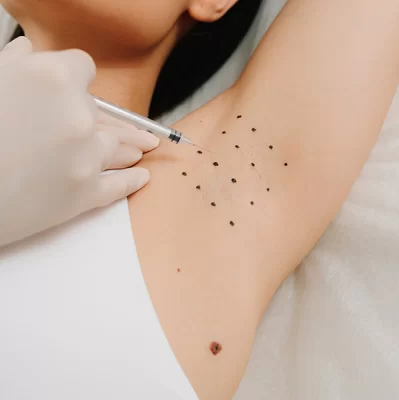Effective treatment of hyperhidrosis
- What is hyperhidrosis and when does it require treatment?
- What are the methods of treating excessive sweating?
- Treating hyperhidrosis with botulinum toxin: what does the procedure involve?
- What treatments permanently reduce armpit sweating?
- When is surgical treatment used for hyperhidrosis and what are its effects?
- How to choose the most effective treatment for yourself?
Hyperhidrosis is a condition characterized by excessive sweating, significantly exceeding the body's thermoregulatory needs. This is the result of increased activity of eccrine sweat glands, stimulated by acetylcholine in the sympathetic nervous system.
There are two main types of this condition: primary (idiopathic) and secondary. Secondary type often accompanies other disorders, such as diabetes or thyroid issues. Medical intervention becomes necessary when increased sweating significantly affects daily quality of life.
The diagnostic process of hyperhidrosis requires consultation with a specialist - a dermatologist, internist, or neurologist. To exclude secondary causes of the condition, laboratory tests such as complete blood count, fasting glucose level, and TSH are necessary. Additionally, precise determination of areas of greatest sweating can be done using the Minor test, also known as the iodine-starch test.
Treating hyperhidrosis is a complex process. Therapy is implemented when sweating significantly impairs a patient's quality of life, always after excluding secondary causes. Treatment begins with basic lifestyle changes, such as proper hygiene and a balanced diet.
The first line of defense against sweat are specialized topical preparations - antiperspirants and sweat blockers. They contain aluminum salts (e.g. aluminum chloride) in high concentrations, which effectively and temporarily block sweat gland openings. Additionally, absorbent powders, talc, and creams with silver nanoparticles or methenamine are used as adjuvants.
If local methods prove ineffective, iontophoresis is recommended. This non-invasive treatment, using direct current, limits the activity of sweat glands, especially in critical areas like hands and feet.
In refractory cases, pharmacological treatment is necessary. Oral medications and supplements used include:
- anticholinergics (e.g. oxybutynin) - systemically inhibiting sweat secretion,
- beta-blockers (e.g. propranolol) - alleviating stress-induced sweating,
- sage,
- nettles,
- lemon balm.
Botox (botulinum toxin) is an extremely effective treatment for excessive sweating. It is used when local treatment methods or iontophoresis have failed. The procedure involves precise injections of small doses of the preparation directly into problematic areas, such as armpits, hands, and feet (less commonly the face). The preparation blocks nerve impulses reaching the sweat glands, temporarily stopping sweat secretion. The treatment is quick (lasting 15-30 minutes) and minimally invasive - always done under local anesthesia for full patient comfort. The therapy is characterized by high effectiveness and long-lasting effects:
- first results are visible as early as 3-5 days after the procedure,
- the full effect typically lasts from 6 to 12 months,
- the therapy is safe and minimally invasive,
- treatment efficacy reaches 87%,
- Botox does not disrupt the body's general thermoregulation.
If a patient is looking for a permanent solution to excessive sweating or cannot undergo botulinum toxin therapy, they should consider alternative treatment methods. The goal of these methods is the permanent destruction of sweat glands under the armpits.
Thermal techniques are very popular, using controlled thermal energy to irreversibly damage the structures responsible for sweat production. The most effective one is microwave ablation, which allows to achieve a reduction in sweating by an average of 82-95% after just one session thanks to precisely targeted microwaves.
Available alternative methods for treating hyperhidrosis include:
- laser therapy,
- microneedle radiofrequency,
- microwave ablation,
- retrodermal curettage,
- liposuction.
The last two procedures are surgical interventions (mechanical methods). These procedures are performed under local anesthesia and involve the physical removal of subcutaneous tissue along with sweat glands.
Sympathectomy is a surgical procedure used as a last resort in the treatment of hyperhidrosis when other methods have failed. It involves precise interruption of the sympathetic nervous system nerve trunk, leading to permanent deactivation of sweat glands in the selected area. There are two types: the thoracic (dedicated to hands) and the lumbar (used for excessive sweating of the feet).
Although the procedure is highly effective and provides almost 100% effectiveness, it is rarely used due to high risk of complications. The most serious and very common adverse effect of the procedure is compensatory hyperhidrosis. This phenomenon involves increased sweating in other untreated areas of the body, such as back, abdomen, or thighs. Unfortunately, this problem can be more troublesome than the original condition. Therefore, before deciding on the procedure, it is necessary to carefully analyze the indications for surgical treatment.
The optimal strategy for treating hyperhidrosis depends on the individual patient's acceptance of risk. The choice of therapy method requires an analysis of key factors:
- location and intensity of the problem,
- invasiveness of individual treatment methods,
- duration of results,
- treatment costs,
- potential side effects,
- individual risk acceptance.
The least invasive method of treating hyperhidrosis is the use of topical preparations and iontophoresis. However, their effectiveness depends on regular repetition. A minimally invasive method that provides long-lasting effects is botulinum toxin injections.
When the priority is a lasting effect, ablative procedures such as microwave technique should be considered. They guarantee a lasting reduction of hyperhidrosis (especially in the armpit area), although they come with higher costs.
Sympathectomy remains the most invasive method, used only as a last resort due to the risk of irreversible compensatory sweating. The final treatment plan always requires an individual approach and must be established during a consultation with a specialist.
